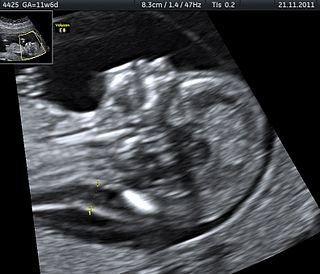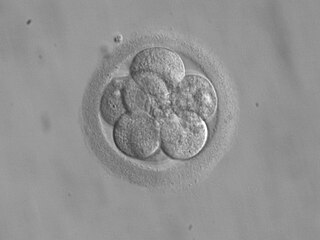Intact dilation and extraction is a surgical procedure that terminates and removes an intact fetus from the uterus. The procedure is used both after miscarriages and for abortions in the second and third trimesters of pregnancy.

Stillbirth is typically defined as fetal death at or after 20 or 28 weeks of pregnancy, depending on the source. It results in a baby born without signs of life. A stillbirth can often result in the feeling of guilt or grief in the mother. The term is in contrast to miscarriage, which is an early pregnancy loss, and sudden infant death syndrome, where the baby dies a short time after being born alive.

The Unborn Victims of Violence Act of 2004 is a United States law that recognizes an embryo or fetus in utero as a legal victim, if they are injured or killed during the commission of any of over 60 listed federal crimes of violence. The law defines "child in utero" as "a member of the species Homo sapiens, at any stage of development, who is carried in the womb."
The rule of felony murder is a legal doctrine in some common law jurisdictions that broadens the crime of murder: when someone is killed in the commission of a dangerous or enumerated crime, the offender, and also the offender's accomplices or co-conspirators, may be found guilty of murder.
Coffin birth, also known as postmortem fetal extrusion, is the expulsion of a nonviable fetus through the vaginal opening of the decomposing body of a deceased pregnant woman due to increasing pressure from intra-abdominal gases. This kind of postmortem delivery occurs very rarely during the decomposition of a body. The practice of chemical preservation, whereby chemical preservatives and disinfectant solutions are pumped into a body to replace natural body fluids, have made the occurrence of "coffin birth" so rare that the topic is rarely mentioned in international medical discourse.
Transferred intent is a legal doctrine that holds that, when the intention to harm one individual inadvertently causes a second person to be hurt instead, the perpetrator is still held responsible. To be held legally responsible, a court typically must demonstrate that the perpetrator had criminal intent, that is, that they knew or should have known that another would be harmed by their actions and wanted this harm to occur. For example, if a murderer intends to kill John, but accidentally kills George instead, the intent is transferred from John to George, and the killer is held to have had criminal intent.
Trover is a form of lawsuit in common law jurisdictions for recovery of damages for wrongful taking of personal property. Trover belongs to a series of remedies for such wrongful taking, its distinctive feature being recovery only for the value of whatever was taken, not for the recovery of the property itself.
Tortious interference, also known as intentional interference with contractual relations, in the common law of torts, occurs when one person intentionally damages someone else's contractual or business relationships with a third party, causing economic harm. As an example, someone could use blackmail to induce a contractor into breaking a contract; they could threaten a supplier to prevent them from supplying goods or services to another party; or they could obstruct someone's ability to honor a contract with a client by deliberately refusing to deliver necessary goods.
The Law French phrase en ventre sa mere refers to a fetus in utero and is commonly used in Legal English.
Feres v. United States, 340 U.S. 135 (1950), combined three pending federal cases for a hearing in certiorari in which the Supreme Court of the United States held that the United States is not liable under the Federal Tort Claims Act for injuries to members of the armed forces sustained while on active duty and not on furlough and resulting from the negligence of others in the armed forces. The opinion is an extension of the English common-law concept of sovereign immunity.
The born alive rule is a common law legal principle that holds that various criminal laws, such as homicide and assault, apply only to a child that is "born alive". U.S. courts have overturned this rule, citing recent advances in science and medicine, and in several states feticide statutes have been explicitly framed or amended to include fetuses in utero. Abortion in Canada is still governed by the born alive rule, as courts continue to hold to its foundational principles. In 1996, the Law Lords confirmed that the rule applied in English law but that alternative charges existed in lieu, such as a charge of unlawful or negligent manslaughter instead of murder.
Hedonic damages is a legal term that first emerged in 1985 in the research of Stan V. Smith, who was a PhD student in economics at the University of Chicago. The term refers to damages for loss of enjoyment of life, the intangible value of life, as distinct from the human capital value or lost earnings value.

The beginning of human personhood is the moment when a human is first recognized as a person. There are differences of opinion as to the precise time when human personhood begins and the nature of that status. The issue arises in a number of fields including science, religion, philosophy, and law, and is most acute in debates relating to abortion, stem cell research, reproductive rights, and fetal rights.
Wrongful birth is a legal cause of action in some common law countries in which the parents of a congenitally diseased child claim that their doctor failed to properly warn of their risk of conceiving or giving birth to a child with serious genetic or congenital abnormalities. Thus, the plaintiffs claim, the defendant prevented them from making a truly informed decision as to whether or not to have the child. Wrongful birth is a type of medical malpractice tort. It is distinguished from wrongful life, in which the child sues the doctor.

On March 19, 1906, Ed Johnson, a young African American man, was murdered by a lynch mob in his home town of Chattanooga, Tennessee. He had been wrongfully sentenced to death for the rape of Nevada Taylor, but Justice John Marshall Harlan of the United States Supreme Court had issued a stay of execution. To prevent delay or avoidance of execution, a mob broke into the jail where Johnson was held, and abducted and lynched him from the Walnut Street Bridge.

Cahoon v. Cummings, 734 N.E.2d 535, was a case decided by the Indiana Supreme Court that adopted the loss of a chance doctrine for tort liability.
Foeticide, or feticide, is the act of killing a fetus, or causing a miscarriage. Definitions differ between legal and medical applications, whereas in law, feticide frequently refers to a criminal offense, in medicine the term generally refers to a part of an abortion procedure in which a provider intentionally induces fetal demise to avoid the chance of an unintended live birth, or as a standalone procedure in the case of selective reduction.

Born alive laws in the United States are fetal rights laws that extend various criminal laws, such as homicide and assault, to cover unlawful death or other harm done to a fetus in utero or to an infant that has been delivered. The basis for such laws stems from advances in medical science and social perception, which allow a fetus to be seen and medically treated as an individual in the womb and perceived socially as a person, for some or all of the pregnancy.
Hughes v. Fetter, 341 U.S. 609 (1951), is a Supreme Court case involving the conflict of laws between states.
Moragne v. States Marine Lines, Inc., 398 U.S. 375 (1970) is a United States Supreme Court case addressing the remedies under federal maritime law for tortious deaths on state territorial waters.






